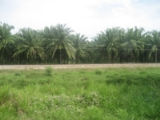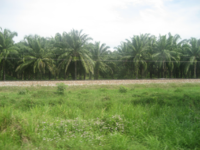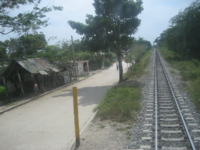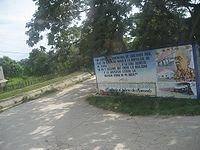
Aracataca
Encyclopedia
Aracataca is a municipality located in the Department
of Magdalena
, in Colombia
's Caribbean Region
. Aracataca is a river town founded in 1885. The town stands beside the river of the same name, the Aracataca river that flows from the nearby Sierra Nevada de Santa Marta
mountain range into the Ciénaga Grande de Santa Marta
. Aracataca is located some 80 km south of the Department capital Santa Marta
.
, Santa Marta
and Cienaga, to the east with the Cesar Department
, to the south with the municipality of Fundación
, and to the west with the municipalities of El Retén
and Pueblo Viejo
.
Aracataca's climate is tropical: warm and humid year-round.
. In the late 19th century companies that would later merge into the United Fruit Company colonized the land and started to cultivate bananas in the wide region. By working closely together with the government and terrorizing their workers the term banana republic has come in to popular use. After some decades the downfall of the company iniciated and completed soon after, partly because of the worldwide recession and the war soon after.
Eversince then the town has been hidden behind a curtain of violence and forgetfullness until it has recently been rediscovered by local artists and foreign investors.
On June 25, 2006, a referendum to rename the town "Aracataca-Macondo" failed due to a low turnout.
Aracataca contains 13 veredas:
The town of Aracataca has 33 Barrios: La Esperanza, La esmeralda, Zacapita, 2 de febrero, 20 de Julio, Ayacucho, Nariño, Loma Fresca, 7 de Agosto, El Carmen, Cataquita, Macondo, El Suiche, El Pradito, 11 de Noviembre, 7 de Abril, Ciudadela macondo, San José, Base, Marujita, Las delicias, Centro, Boston, El Porvenir, 1 de Mayo, Galán, San Martín, Bello Horizonte, Raíces, Macondo, Villa del Río I y II.
 Aracataca relies heavily on agriculture, mainly producing Oil palm
Aracataca relies heavily on agriculture, mainly producing Oil palm
, rice
, cotton
, sugar cane, common bean
, plantain
, banana
s, yuca
, tomato
and on livestock
raising like cattle, equines, mules, donkeys, domesticated
bird
s, goats and pigs. Commerce represents another form of income and is mostly done informally, especially along the main highway to Santa Marta where large lines of stands selling beach towels are placed.
 There are several companies that offer inter-municipal and inter-departamental transportation on medium-size buses, minivan
There are several companies that offer inter-municipal and inter-departamental transportation on medium-size buses, minivan
s and taxi cabs. Most tourists and locals use Berlinas del Fonce which has busses leaving the Santa Marta terminal every 30 minutes between 5am and 6pm. $9.000 p.p.
From the transportation office in Aracataca you can get almost everywhere using a ciclotaxi for just $1.000 p.p.
The rivers are not navigable and there are a few small rudimentary airfields used by small aircraft for agricultural fumigation. The municipality and town are crossed by the Highway 45 that extends from Santa Marta
, crosses Aracataca, Fundación
, El Copey
, Bosconia
, Curumani
into the Cesar Department and turns south towards the Colombian Andean Region. The railway no longer works for public transportation, it is used almost exclusively to transport coal
from the region of La Loma Calentura in the Cesar Department to the Port of Santa Marta.
and the holy week
between February and March, a cultural week, The Festival of the Unedited Song (Festival de la Canción Inédita), The municipality's anniversary in April and the River Festival (Festival del Río).
The Fiestas Patronales which consist of large outdoor concerts and semi bullfights this year is being held from the 15th of July till the 24th.
The first hostel in Aracataca opened in late 2010; The Gypsy Residence. www.thegypsyresidence.com Tel; 3212517420. It's a modern and friendly hostel where you can receive all the information about Garcia Marquez and the rich history of the town. The Gypsy is a Netherlandic Macondonian and shows you the beginninge of your journey of being a character in a nobelprize-winning novel.
It is just a couple of blocks away from the most important museums in town; The Museum House and the Casa del Telegrafista.
The recently renovated Train Station will serve as an exhibition hall for fotos made by another famous son of Aracataca; Leo Matiz

Departments of Colombia
Colombia is an unitary republic formed by thirty-two departments and a Capital District . Each department has a Governor and a Department Assembly , elected by popular vote for a four-year period. The governor cannot be re-elected in consecutive periods...
of Magdalena
Magdalena Department
Magdalena is a department of Colombia, located to the north of the country by the Caribbean Sea. The capital of the Magdalena Department is Santa Marta and was named after the Magdalena River...
, in Colombia
Colombia
Colombia, officially the Republic of Colombia , is a unitary constitutional republic comprising thirty-two departments. The country is located in northwestern South America, bordered to the east by Venezuela and Brazil; to the south by Ecuador and Peru; to the north by the Caribbean Sea; to the...
's Caribbean Region
Caribbean Region
The Caribbean Region or Caribbean Coast Region is a natural region of Colombia mainly composed of eight Departments located contiguous to the Caribbean. The area covers a total land area of including the San Andres Island Archipelago of San Andrés, Providencia and Santa Catalina in the Caribbean...
. Aracataca is a river town founded in 1885. The town stands beside the river of the same name, the Aracataca river that flows from the nearby Sierra Nevada de Santa Marta
Sierra Nevada de Santa Marta
The Sierra Nevada de Santa Marta is an isolated mountain range apart from the Andes chain that runs through Colombia. Reaching an altitude of 5,700 metres above sea level just 42 km from the Caribbean coast, the Sierra Nevada is the world's highest coastal range...
mountain range into the Ciénaga Grande de Santa Marta
Ciénaga Grande de Santa Marta
The Ciénaga Grande de Santa Marta is the largest of the swampy marshes located between the Magdalena River and the Sierra Nevada de Santa Marta, weakly separated from the Caribbean Sea by a narrow strait....
. Aracataca is located some 80 km south of the Department capital Santa Marta
Santa Marta
Santa Marta is the capital city of the Colombian department of Magdalena in the Caribbean Region. It was founded in July 29, 1525 by the Spanish conqueror Rodrigo de Bastidas, which makes it the oldest remaining city in Colombia...
.
Geography and climate
The municipality borders to the north with the municipalities of Zona BananeraZona Bananera, Magdalena
Zona Bananera is a municipality of the Magdalena Department in northern Colombia. Its main town is Prado Sevilla.-External links:...
, Santa Marta
Santa Marta
Santa Marta is the capital city of the Colombian department of Magdalena in the Caribbean Region. It was founded in July 29, 1525 by the Spanish conqueror Rodrigo de Bastidas, which makes it the oldest remaining city in Colombia...
and Cienaga, to the east with the Cesar Department
Cesar Department
Cesar Department or simply Cesar is a department of Colombia located in the north of the country in the Caribbean region, bordering to the north with the Department of La Guajira, to the west with the Department of Magdalena and Department of Bolivar, to the south with Department of Santander, to...
, to the south with the municipality of Fundación
Fundación
Fundación is a town and municipality of the Colombian Department of Magdalena. Its people are known as Fundanenses. The primary economic activity is livestock-raising, for production of both meat and milk. Other crops are: corn, yuca, oranges, bananas, beans, sesame, sorghum, rice, tomatoes,...
, and to the west with the municipalities of El Retén
El Retén
El Retén is a town and municipality of the Magdalena Department in northern Colombia.-External links:...
and Pueblo Viejo
Pueblo Viejo, Magdalena
Puebloviejo is a town and municipality of the Colombian Department of Magdalena. It was founded in 1526 by friar Tomas Ortíz. It was erected a municipality on May 3, 1929...
.
Aracataca's climate is tropical: warm and humid year-round.
History
Aracatacaa was founded in 1885. It achieved the status of municipality on the 28th of April 1915, when it separated from the municipality of Pueblo ViejoPueblo Viejo, Magdalena
Puebloviejo is a town and municipality of the Colombian Department of Magdalena. It was founded in 1526 by friar Tomas Ortíz. It was erected a municipality on May 3, 1929...
. In the late 19th century companies that would later merge into the United Fruit Company colonized the land and started to cultivate bananas in the wide region. By working closely together with the government and terrorizing their workers the term banana republic has come in to popular use. After some decades the downfall of the company iniciated and completed soon after, partly because of the worldwide recession and the war soon after.
Eversince then the town has been hidden behind a curtain of violence and forgetfullness until it has recently been rediscovered by local artists and foreign investors.
On June 25, 2006, a referendum to rename the town "Aracataca-Macondo" failed due to a low turnout.
Veredas
Aracataca contains 13 veredas:
- Tehobromina
- El Torito
- Macaraquilla
- La escondida
- Bocatoma
- La Ribiera
- La Fuente
- Cerro Azul
- El Volante
- El porvenir
- Marimonda
Neighborhoods
The town of Aracataca has 33 Barrios: La Esperanza, La esmeralda, Zacapita, 2 de febrero, 20 de Julio, Ayacucho, Nariño, Loma Fresca, 7 de Agosto, El Carmen, Cataquita, Macondo, El Suiche, El Pradito, 11 de Noviembre, 7 de Abril, Ciudadela macondo, San José, Base, Marujita, Las delicias, Centro, Boston, El Porvenir, 1 de Mayo, Galán, San Martín, Bello Horizonte, Raíces, Macondo, Villa del Río I y II.
Economy

Oil palm
The oil palms comprise two species of the Arecaceae, or palm family. They are used in commercial agriculture in the production of palm oil. The African Oil Palm Elaeis guineensis is native to West Africa, occurring between Angola and Gambia, while the American Oil Palm Elaeis oleifera is native to...
, rice
Rice
Rice is the seed of the monocot plants Oryza sativa or Oryza glaberrima . As a cereal grain, it is the most important staple food for a large part of the world's human population, especially in East Asia, Southeast Asia, South Asia, the Middle East, and the West Indies...
, cotton
Cotton
Cotton is a soft, fluffy staple fiber that grows in a boll, or protective capsule, around the seeds of cotton plants of the genus Gossypium. The fiber is almost pure cellulose. The botanical purpose of cotton fiber is to aid in seed dispersal....
, sugar cane, common bean
Common bean
Phaseolus vulgaris, the common bean, is an herbaceous annual plant domesticated independently in ancient Mesoamerica and the Andes, and now grown worldwide for its edible bean, popular both dry and as a green bean. The leaf is occasionally used as a leaf vegetable, and the straw is used for fodder...
, plantain
Plantain
Plantain is the common name for herbaceous plants of the genus Musa. The fruit they produce is generally used for cooking, in contrast to the soft, sweet banana...
, banana
Banana
Banana is the common name for herbaceous plants of the genus Musa and for the fruit they produce. Bananas come in a variety of sizes and colors when ripe, including yellow, purple, and red....
s, yuca
Cassava
Cassava , also called yuca or manioc, a woody shrub of the Euphorbiaceae native to South America, is extensively cultivated as an annual crop in tropical and subtropical regions for its edible starchy tuberous root, a major source of carbohydrates...
, tomato
Tomato
The word "tomato" may refer to the plant or the edible, typically red, fruit which it bears. Originating in South America, the tomato was spread around the world following the Spanish colonization of the Americas, and its many varieties are now widely grown, often in greenhouses in cooler...
and on livestock
Livestock
Livestock refers to one or more domesticated animals raised in an agricultural setting to produce commodities such as food, fiber and labor. The term "livestock" as used in this article does not include poultry or farmed fish; however the inclusion of these, especially poultry, within the meaning...
raising like cattle, equines, mules, donkeys, domesticated
Domestication
Domestication or taming is the process whereby a population of animals or plants, through a process of selection, becomes accustomed to human provision and control. In the Convention on Biological Diversity a domesticated species is defined as a 'species in which the evolutionary process has been...
bird
Bird
Birds are feathered, winged, bipedal, endothermic , egg-laying, vertebrate animals. Around 10,000 living species and 188 families makes them the most speciose class of tetrapod vertebrates. They inhabit ecosystems across the globe, from the Arctic to the Antarctic. Extant birds range in size from...
s, goats and pigs. Commerce represents another form of income and is mostly done informally, especially along the main highway to Santa Marta where large lines of stands selling beach towels are placed.
Transportation

Minivan
Minivan is a type of van designed for personal use. Minivans are typically either two-box or one box designs for maximum interior volume – and are taller than a sedan, hatchback, or a station wagon....
s and taxi cabs. Most tourists and locals use Berlinas del Fonce which has busses leaving the Santa Marta terminal every 30 minutes between 5am and 6pm. $9.000 p.p.
From the transportation office in Aracataca you can get almost everywhere using a ciclotaxi for just $1.000 p.p.
The rivers are not navigable and there are a few small rudimentary airfields used by small aircraft for agricultural fumigation. The municipality and town are crossed by the Highway 45 that extends from Santa Marta
Santa Marta
Santa Marta is the capital city of the Colombian department of Magdalena in the Caribbean Region. It was founded in July 29, 1525 by the Spanish conqueror Rodrigo de Bastidas, which makes it the oldest remaining city in Colombia...
, crosses Aracataca, Fundación
Fundación
Fundación is a town and municipality of the Colombian Department of Magdalena. Its people are known as Fundanenses. The primary economic activity is livestock-raising, for production of both meat and milk. Other crops are: corn, yuca, oranges, bananas, beans, sesame, sorghum, rice, tomatoes,...
, El Copey
El Copey
El Copey is a town and municipality in the Colombian Department of Cesar.-External links:...
, Bosconia
Bosconia
Bosconia is a town and municipality in the Colombian Department of Cesar.-Geography:The municipality of Bosconia is located in the northwestern part of the Cesar Department...
, Curumani
Curumaní
Curumaní is a town and municipality in the Colombian Department of Cesar.-External links:...
into the Cesar Department and turns south towards the Colombian Andean Region. The railway no longer works for public transportation, it is used almost exclusively to transport coal
Coal
Coal is a combustible black or brownish-black sedimentary rock usually occurring in rock strata in layers or veins called coal beds or coal seams. The harder forms, such as anthracite coal, can be regarded as metamorphic rock because of later exposure to elevated temperature and pressure...
from the region of La Loma Calentura in the Cesar Department to the Port of Santa Marta.
Festivities
Aracatacans celebrate the Roman Catholic tradition of Three Kings on January 6 of every year, CarnivalsCarnival in Colombia
The carnival in Colombia was introduced by the Spanish. The Colombian carnival has incorporated elements from European culture, and has managed to syncretise, or re-interpret, traditions that belonged to the African and Amerindian cultures of Colombia...
and the holy week
Holy Week
Holy Week in Christianity is the last week of Lent and the week before Easter...
between February and March, a cultural week, The Festival of the Unedited Song (Festival de la Canción Inédita), The municipality's anniversary in April and the River Festival (Festival del Río).
The Fiestas Patronales which consist of large outdoor concerts and semi bullfights this year is being held from the 15th of July till the 24th.
Tourism
Though at the moment tourism is still virgin in town, it has been said that in 10 years Aracataca will be in the top 10 Colombian destinations visited by foreigners. This because Aracataca serves, and does more everyday, as a symbol for LatinAmerican towns; proud of their rich history, nature and culture.The first hostel in Aracataca opened in late 2010; The Gypsy Residence. www.thegypsyresidence.com Tel; 3212517420. It's a modern and friendly hostel where you can receive all the information about Garcia Marquez and the rich history of the town. The Gypsy is a Netherlandic Macondonian and shows you the beginninge of your journey of being a character in a nobelprize-winning novel.
It is just a couple of blocks away from the most important museums in town; The Museum House and the Casa del Telegrafista.
The recently renovated Train Station will serve as an exhibition hall for fotos made by another famous son of Aracataca; Leo Matiz
In popular culture

- The town is the birthplace of Nobel Prize Winning author Gabriel García MárquezGabriel García MárquezGabriel José de la Concordia García Márquez is a Colombian novelist, short-story writer, screenwriter and journalist, known affectionately as Gabo throughout Latin America. He is considered one of the most significant authors of the 20th century. He was awarded the Nobel Prize in Literature in...
and is widely recognized as the model for the mythical "MacondoMacondoFor the oil spill, see: Deepwater Horizon drilling rig explosionMacondo is a fictional town described in Gabriel García Márquez's novel One Hundred Years of Solitude. It is the home town of the Buendía family.-Aracataca:...
", the central village in García Márquez's masterpiece, One Hundred Years of SolitudeOne Hundred Years of SolitudeOne Hundred Years of Solitude , by Gabriel García Márquez, is a novel which tells the multi-generational story of the Buendía family, whose patriarch, José Arcadio Buendía, founds the town of Macondo, the metaphoric Colombia...
. Today his childhood home, now the Casa Museo, and the church where he was baptised are both major tourist attractions.

